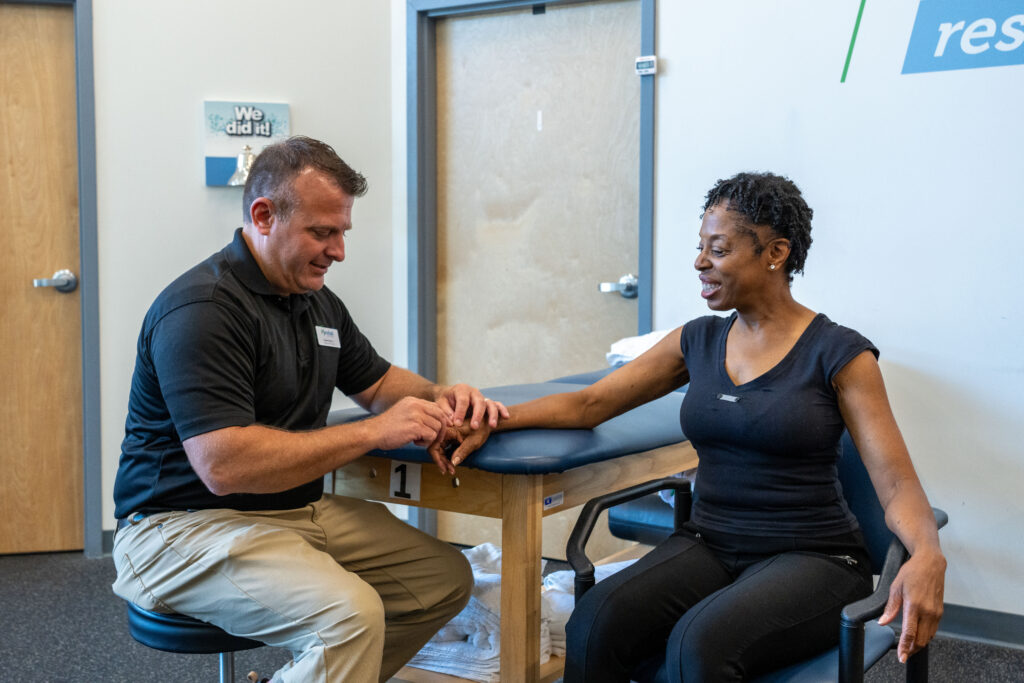This content was updated for accuracy and relevance on June 9, 2023
Osteoarthritis is a common condition involving the chronic degeneration of the cartilage that covers the ends of a bone. The cartilage degeneration then produces ongoing micro-damage within joint spaces as the bones rub against each other, reducing the smoothness of joint motion.
Common symptoms include:
- Morning stiffness that resolves within the first hour of the day
- Pain with weight-bearing
- Creaking or crackling (known as crepitus) at the affected painful joint.
Symptoms can increase with age, weight, genetic factors, and repeated stress such as squatting or kneeling. The good news is that various strategies exist to effectively treat and control arthritis and prevent it from worsening. Simple changes can also help when learning how to manage arthritis pain.
Can arthritis pain be controlled?
Arthritis can occur anywhere throughout the body but is most common at weight-bearing joints such as the spine, knees, and hips. There is no cure for arthritis, but there are strategies to control the condition with minimal symptoms.
Movement
A common phrase that applies in controlling osteoarthritis is “motion is lotion.” Avoiding inactivity by maintaining a daily movement program is key to managing arthritis. This includes strength training, aerobic conditioning, and flexibility exercise. Pain-free strength exercise helps to build muscles surrounding the painful joint, allowing you to complete your daily activity with greater stability and tolerance. For example, it is important to strengthen the core to support the spine so that you can bend, carry, and lift. For the knees, it is beneficial to strengthen the quadriceps so that you can walk and navigate stairs without joint pain.
Aerobic activity
There are several benefits of exercise for arthritis patients. Aerobic activity is equally important in controlling arthritis. It promotes circulation, reduces joint inflammation, and encourages tissue healing at the joints. This may include brisk daily walking, swimming, or any other form of exercise that elevates your heart rate and breathing rate. While inactivity may lead to brittle bones and joint stiffness, regular walking helps to improve bone health and pain-free mobility.
However, there are also activities you should avoid doing. These can include running, playing tennis, high-impact aerobics, and repetition of specific exercises.
Stretching
Stretching of the muscles surrounding the affected joints is also critical in promoting a pain-free range of motion. Osteoarthritis involves reduced space between two bones of a joint, which leads to increased stiffness in the body. By practicing flexibility exercises daily, you can regain smoother freedom of motion in the affected joint space.
Heating or cold pad
Depending on individual preference, symptoms can be controlled by applying a heating pad or cold pack at the joint for up to 15 minutes. Evidence tends to suggest heat therapy for chronic pain management and cold therapy for more acute conditions. When it comes to osteoarthritis, either can be helpful in providing relief for a painful joint. So for pain management, you may try either method and see which one is preferred.
Rheumatoid arthritis, a different form of arthritis, is an autoimmune disorder in which the body erodes its own cartilage. It produces morning stiffness, pain, and warmth, more typically at smaller joints of the body. It also leads to more full-body symptoms such as general fatigue and malaise. Strategies for controlling osteoarthritis apply to managing rheumatoid arthritis too. However, as it is an autoimmune disorder, it is important to also address this condition with a medical professional
How can I stop my arthritis from getting worse?
When managing osteoarthritis, it is essential to examine your daily habits and identify those that are negatively impacting your joint health. Here are some changes or implementations for managing arthritis pain and preventing arthritis symptoms:
Motion is Lotion
Sitting for long periods of time promotes joint stiffness. On the other hand, movement by taking standing breaks and going for daily walks helps you to stay mobile and pain-free. Remember, motion is lotion! Find ways to incorporate physical activity such as strength, flexibility, and aerobic exercise into your day to prevent an arthritic joint from worsening.
If already active, make sure to avoid repetitive stress on the affected joint. For example, running every single day may overload the weight-bearing joints. So it would be beneficial to switch up the program by running a few times per week and swimming or bicycling the other days.
Healthy Habits
Weight management is another great strategy for preventing arthritis symptoms from getting worse. Obesity is a risk factor to osteoarthritis, as it places extra stress on the hips and knees. Studies indicate that weight loss can significantly reduce pain and stiffness in weight-bearing joints. This may be accomplished through finding a sustainable exercise program or a more nutritious eating lifestyle.
A general health tip to keep in mind is that cigarette smoking impedes tissue healing. Research has found a strong correlation between smoking and all types of arthritis, including both osteoarthritis and rheumatoid arthritis. So make sure to quit the habit if you are a current cigarette smoker.
Sufficient consumption of Vitamin D is essential for bone health and strength as it encourages the body to absorb calcium. This can be achieved by spending time outside in the sunshine, eating vitamin D-rich foods such as fish and eggs, and using supplements.
Practice Good Posture
Improving posture can help to stop joint pain from worsening. Good posture allows joints to stay properly aligned with each other and maintain smooth motion. Meanwhile, poor posture forces excess strain on the joints. To protect the shoulders, it is important to keep the shoulder blades down and back rather than elevated and tipped forward. To protect the spine, it is important to avoid slumping forward when seated or standing.
Wondering how to prevent arthritis? Healthful habits produce major long-term effects on preventing painful arthritic joints from becoming even more stiff and painful. Daily activity, weight loss, quitting smoking, a nutritious diet, and good posture are all beneficial strategies for keeping arthritic symptoms from getting worse.
What is the most effective treatment for arthritis?
Besides arthritis pain management, you may also be wondering about the most effective treatment option, especially if you’re experiencing chronic pain or joint inflammation. Aquatic therapy has consistently been proven to be a highly effective treatment option for arthritis. It may reduce swelling and help with joint mobility. When immersed in water, body weight and movement apply less stress to the arthritic joints. Therefore, strength training, balance exercise, and stretching can all be performed more easily in a pool to promote the pain-free articulation of arthritic joints. Walking through a heated pool can also allow for smooth joint motion while promoting circulation and tissue healing.
Prevention is just as important though, in proactively treating arthritis. Addressing risk factors such as inactivity, weight, repetitive loading stress, and unhealthful habits will go a long way in preventing the human body from experiencing joint stiffness, inflammation, and pain.
How Physical Therapy Can Help
Physical therapy is an essential component of arthritis pain management. Here at Ivy Rehab, we can collaborate with you to put together the most effective program of exercises to reduce arthritic pain, stiffness, and swelling. In addition, the physical therapist is an expert in providing manual therapy techniques that help to promote joint mobility, reduce stress on the joints, provide arthritis pain relief, and reduce inflammation.
We can also identify lifestyle strategies for promoting more healthful behaviors to prevent symptoms from worsening. This may include helping you to find activity modifications, begin a sustainable weight loss program, or practice unloading the arthritic joint. Our healthcare providers can assess your movement patterns and train you to accomplish your daily activities in safer ways that will feel better and prevent joint damage. Ivy Rehab therapists can provide a comprehensive treatment program to help manage arthritis pain and optimize your overall health and wellness. Click here to find a location near you.
Article By: Sheena Gopal, DPT
Sheena began her physical therapy career three years ago. She loves working with the general population and believes in the importance of providing a collaborative space to achieve goals through the power of movement. Sheena enjoys working with dancers and performing artists to reach their full potential. She currently treats patients at Elite Physical Therapy through Ivy Rehab in Providence, Rhode Island.





